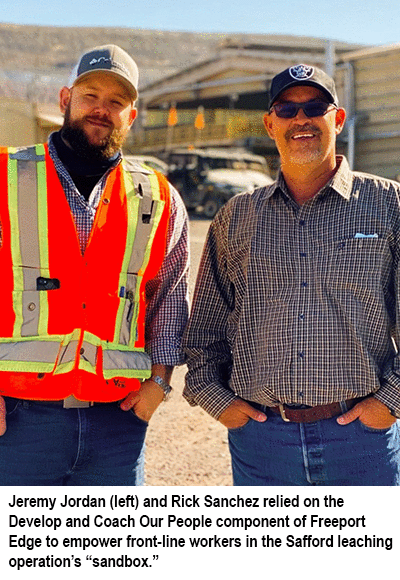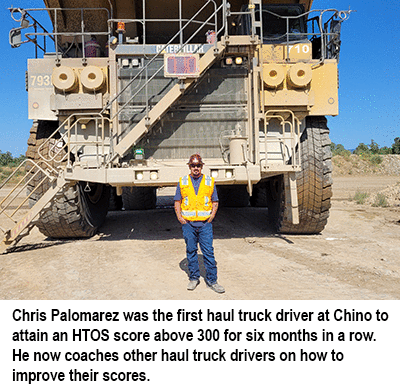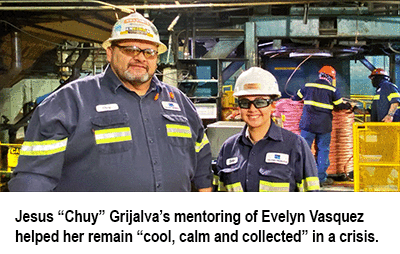(October 8, 2021) Freeport Edge is a way to help every employee reach their highest potential.
It encourages everyone to challenge the status-quo, set ambitious goals, work with others and feel confident enough to do the things that will bring enhanced value to both themselves and the company.
But beyond those behaviors that empower the individual is Develop and Coach, which encourages every employee to become a teacher willing to share their skills, practices and experiences with their peers, direct reports and supervisors.
When everyone embraces Develop and Coach behaviors, we can unlock peoples’ full potential, said Shannon Lijek, Vice President-Transformational and Organizational Development.
“The developing and coaching of people is the behavior that helps to progress the other behaviors,” Lijek said. “The beauty of this is that we all have the opportunity to help others grow, and that’s what this one is all about. It’s taking on the role of a coach, regardless of your position in the company, as well as being the student and taking the time to listen and learn from others.”
Freeport Edge is a set of five behaviors instituted more than a year ago to unleash the talents of all employees and harness them to sharpen the company’s competitive edge. Workers are encouraged to Aim High, Pursue Value, Collaborate as One Freeport and be Empowered to Act, all behaviors that will allow them to better their own performance. The final element, Develop and Coach Our People, enlists everyone to improve the skills of others.
(To learn more about how Freeport employees have adopted Develop and Coach Our People and the other Freeport Edge behaviors, click here to view a series of short videos.)
Embracing those behaviors helped transform the leaching department at Safford to improve productivity, increase morale and hone the talents of every employee by giving them more say in how the work gets done, said Jeremy Jordan, Senior Supervisor-Hydromet Leaching.
When the list of Freeport Edge behaviors came out, Jordan said he was miffed to see Develop and Coach Our People at the bottom. In his view, it may be the most important component. Without it, none of the others can succeed.
“Develop and Coach is the foundation for every one of those attributes that are sitting above it,” Jordan said. “If you don’t have it, then you can’t build those. If I’m not developed and coached well, then how do I know to aim high? What value am I going to tackle? What action am I going to take if I don’t know what action to take? So you can’t do any of those things without looking at the very foundation of it.”
Coaching in the ‘sandbox’
As workloads increased at the Safford leaching plant, Jordan and his manager, Rick Sanchez, Superintendent-Hydromet Leaching, knew they needed to find a way to increase productivity with the staff they had. Using the skills they learned on agile teams, they decided to involve front-line workers more in the decision- making.
making.
Several months ago, they implemented a new method of dividing the work known as the “sandbox.” Front-line employees are given a detailed description of the work to be done and decide among themselves how best to organize their crews to achieve that goal.
Develop and Coach was critical to the success of the sandbox, Sanchez said. Sharing the responsibility means it is in everyone’s interest to make certain their co-workers are trained and performing to their fullest potential. That has led to greater peer-to-peer mentoring and a more hands-on approach to making sure everyone knows their job and does it well.
If someone is struggling, more experienced co-workers and designated mentors on each crew are there to help them improve their skills on a peer-to-peer basis rather than leaving it to a supervisor to correct any shortcomings.
Each of the four leaching crews has two designated mentors who help coach their co-workers in addition to their regular duties. Front-line workers are so committed to Develop and Coach that they worked with supervisors and safety experts to draft their own training book for new employees.
“It creates ownership with people’s personal development,” Sanchez said. “The peer-to-peer coaching is just as tough sometimes, but it lets people look at it as not being picked on by a supervisor. It allows them the opportunity to look at it from somebody else who is doing the same kind of work. This is the guy that’s working right next to me.”
Strong link in the chain
Chris Palomarez, Truck Driver 1-Chino, is another company employee who puts a high premium on the Develop and Coach component of Freeport Edge. The commitment to mentoring others shown by Palomarez and other drivers on his crew has consistently produced some of the top numbers in the company on the Haul Truck Operator Scorecard (HTOS), utilization of equipment and tonnage moved, said Rod Dalton, Senior Supervisor-Mine Operations.
crew has consistently produced some of the top numbers in the company on the Haul Truck Operator Scorecard (HTOS), utilization of equipment and tonnage moved, said Rod Dalton, Senior Supervisor-Mine Operations.
The HTOS rates haul truck drivers daily by continuously monitoring their performance. The company’s goal for each driver is a score of at least 260.
That wasn’t good enough for Palomarez, who “thrives on being the best,” Dalton said. He honed his skills and quickly corrected any shortcomings, and recently became the first driver at Chino to attain an HTOS score of 300 or more every day for six months.
That still wasn’t good enough. Palomarez is constantly working with other drivers to improve their scores, sometimes coming in on his days off for the one-on-one mentoring sessions. First, he’ll talk them through the procedures and explain how to correct their weaknesses. Then he’ll either watch the other driver and give pointers or get behind the wheel himself to demonstrate his techniques – whatever it takes to make every driver on the crew reach peak performance.
Palomarez said he is committed to developing and coaching his co-workers because their success makes the whole team stronger.
“The crew is only as strong as its weakest link,” Palomarez said. “If I’ve got somebody that’s struggling, then the whole crew is going to struggle whether there’s good scores or not. If I can get that one person or those people who are struggling and bring them up, then everybody’s happy, everybody’s on the same page, everybody’s running the same way and running smart and safe.”
Patience is key to mentoring, Palomarez said. Some people learn best when a technique is explained verbally or in writing. For others, the best teaching method is hands-on behind the wheel. Getting to know the person being trained is key to finding the right approach, he said.
“For me I would say this crew is more of a family than a crew,” Palomarez said. “I didn’t get where I got by myself. I had the crew helping me. I was hearing people that figured something out, and I took that information and used it myself and I was able to excel. So, all I do is take information from other people and make it fit, and that’s how I’m able to show other people how to drive and how to operate.”
Cool, calm and collected
At the rod plant in El Paso, the payoff for the mentoring done by Jesus “Chuy” Grijalva, Supervisor-Rod Mill, came as suddenly as a summer storm, literally.

Grijalva had spent much of the morning of July 18, coaching Evelyn Vasquez, a Metallurgist who was training to become a supervisor. The message he continuously emphasized was that in any situation, she needed to remain cool, calm and collected. That was especially important in an emergency.
That afternoon a freak storm blew through El Paso, producing winds of 60 mph and dumping so much rain that soon it was pouring into the rod mill through roof vents, exhaust fans and equipment doors, drenching the equipment. It was a weekend, so some managers were off. Grijalva took immediate command, ordering heavy electrical equipment to be shut down and ensuring that every worker was safe and accounted for.
Vasquez was beside him, helping to coordinate the shutdown and relaying orders to team leaders throughout the site. She also was responsible for communicating with crews in other parts of the site to make sure they were safe.
When Grijalva’s cellular phone died, he put Vasquez in charge of all emergency communications, giving her the responsibility of coordinating the responses from management, on-site personnel and emergency crews.
When the crisis did come, Vasquez had the confidence to stay calm and make important decisions because of the coaching she’d received from Grijalva, she said.
“He made me feel like I could make decisions,” Vasquez said. “He’s really mentored me to get the confidence to know how to do it. When this happened, I knew right away to stay calm and start thinking of what needs to be done first and starting the work. I feel like that empowered me.”
Beyond staying calm and showing confidence, Grijalva said he tries to teach upcoming leaders how to quickly assess a situation and make the best decisions. Safety is always the first priority, he said.
Shutting down the rod mill full of molten copper and high-voltage equipment while the building was flooding was the right call, he said. But it is also important for leaders like Vasquez to understand why the decisions they make are the right ones and not just snap judgments, Grijalva said.
“The most important thing that I told her was stay cool, calm and collected,” Grijalva said. “I always told her make the decision. Don’t try to make it right off the bat. Evaluate the situation and keep in mind, as all of this is going on around you, that you are not always going to make the best decision. But you need to make the best one at that time while keeping everybody safe.”
